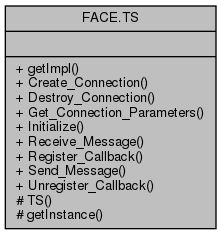|
| static void | Create_Connection (String connection_name, FACE.MESSAGING_PATTERN_TYPE pattern, us.opengroup.FACE.LongHolder connection_id, FACE.CONNECTION_DIRECTION_TYPEHolder connection_direction, us.opengroup.FACE.IntHolder max_message_size, long timeout, FACE.RETURN_CODE_TYPEHolder return_code) |
| | The Transport Services Segment (TSS) provides an interface to create a connection. More...
|
| |
| static void | Destroy_Connection (long connection_id, FACE.RETURN_CODE_TYPEHolder return_code) |
| | The Destroy_Connection function frees up any resources allocated to the connection. More...
|
| |
| static void | Get_Connection_Parameters (us.opengroup.FACE.StringHolder connection_name, us.opengroup.FACE.LongHolder connection_id, FACE.TRANSPORT_CONNECTION_STATUS_TYPEHolder connection_status, FACE.RETURN_CODE_TYPEHolder return_code) |
| | The purpose of Get_Connection_Parameters is to get the information regarding the requested connection. More...
|
| |
| static void | Initialize (String configuration, FACE.RETURN_CODE_TYPEHolder return_code) |
| | The Initialize function call allows for the Portable Components Segment (PCS) and Platform-Specific Services Segment (PSSS) component to trigger the initialization of the Transport Services Segment (TSS) component. More...
|
| |
| static void | Receive_Message (long connection_id, long timeout, us.opengroup.FACE.LongHolder transaction_id, DataTypeHolder message, int message_size, FACE.RETURN_CODE_TYPEHolder return_code) |
| | The Receive_Message Function is used to receive data from another source. More...
|
| |
| static void | Register_Callback (long connection_id, boolean[] waitset, DataTypeRead_CallbackHolder data_callback, int max_message_size, FACE.RETURN_CODE_TYPEHolder return_code) |
| | The purpose of Register_Callback is to provide a mechanism to read data without polling. More...
|
| |
| static void | Send_Message (long connection_id, long timeout, us.opengroup.FACE.LongHolder transaction_id, DataTypeHolder message, us.opengroup.FACE.IntHolder message_size, FACE.RETURN_CODE_TYPEHolder return_code) |
| | The Send_Message Function is used to send data to another source. More...
|
| |
| static void | Unregister_Callback (long connection_id, FACE.RETURN_CODE_TYPEHolder return_code) |
| | The purpose of Unregister_Callback is to provide a mechanism to unregister the callback associated with a connection_id. More...
|
| |
Definition at line 31 of file TS.java.
| static void FACE.TS.Register_Callback |
( |
long |
connection_id, |
|
|
boolean [] |
waitset, |
|
|
DataTypeRead_CallbackHolder |
data_callback, |
|
|
int |
max_message_size, |
|
|
FACE.RETURN_CODE_TYPEHolder |
return_code |
|
) |
| |
|
static |
The purpose of Register_Callback is to provide a mechanism to read data without polling.
This needs to be called on the generated type interface without using the TS Interface. There can only be one callback registration per connection_id.
Possible return codes:
-
NO_ERROR - Successful completion.
-
NO_ACTION - Callback already registered for specified type.
-
INVALID_PARAM - One or more of the parameters are incorrect (e.g., invalid connection identification (ID), invalid callback, invalid message size).
-
NOT_AVAILABLE - Callback/routing function not available (e.g., callback service is not provided in this implementation).
-
INVALID_CONFIG - One or more fields in the configuration data for the connection is invalid (e.g., invalid TSS thread parameters).
Data_callback Example
IMU_DataRead_Callback initial = new FaceReadCallback();
IMU_DataRead_CallbackHolder data_callback = new IMU_DataRead_CallbackHolder(initial);
public class FaceReadCallback implements DataTypeRead_Callback {
{
public void send_event(long transaction_id, DataTypeHolder message, long message_type_id, int message_size,
boolean[] waitset, RETURN_CODE_TYPEHolder return_code) {
do your action here
}
}
- Parameters
-
| connection_id | The connection_id of the connection that needs to be used for the callback. This is an input parameter. |
| waitset | The waitset for DDS this parameter is not relevant. This is an input parameter. |
| data_callback | The data_callback class in which an action can be set on how to react when receiving data. This data_callback is the external operation (interface, which must be implemented by the application see example) that is called by the FACE API when new data is available for this connection. This is an input parameter. |
| max_message_size | The max_message_size for DDS this parameter is not relevant however the max_message_size supplied needs to be less then the max_message_size of the configured connection. This is an input parameter. |
| return_code | the return_code This is an output parameter. |
Definition at line 433 of file TS.java.


